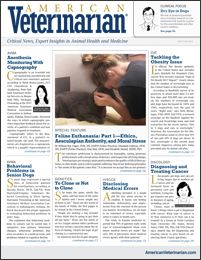Choosing Quality Over Quantity
Euthanasia is the necessary but unfortunate, unavoidable, and unintended consequence to end patient suffering in a manner that minimizes pain, anxiety, and distress.
“To everything there is a season... A time to be born, and a time to die...”
This passage, from the Book of Ecclesiastes (3:1-8), is one of the most quoted from the Bible and speaks volumes in veterinary medicine today. The death of our beloved pets is an unavoidable and brutal fact of life.
Our feature article in this issue—the first of a 2-part series on feline euthanasia—acknowledges that euthanasia is an ever-present moral and ethical dilemma facing veterinarians and support staff in private practice, an emotional upheaval for the pet owner, and a significant source of moral stress and compassion fatigue for everyone involved. Conflicting demands confront the owner, veterinarian, and professional health care team at the end of a cat’s life.
One of the causes of moral stress for the health care team is when a client requests continued care for his or her pet when the veterinarian knows that care will prolong the animal’s suffering. Pets are on solid footing as family members and not simply property, and these requests have, unfortunately, become relatively common in veterinary medicine.
As Dr. William Ray Folger and colleagues so eloquently define it, euthanasia is the necessary but unfortunate, unavoidable, and unintended consequence to end patient suffering in a manner that minimizes pain, anxiety, and distress.
Veterinarians are required to make their patients their first priority. Although modern veterinary medicine can work miracles, veterinarians sometimes need to be reminded that death is inevitable and that when pets are suffering, or soon will be, it is incumbent on them to focus on quality rather than quantity of life to best serve their patients.
Therefore, the authors note, when an animal is suffering and comfort and function cannot be restored, the veterinarian is obliged to open a discussion with that pet owner about quality of life. And, they say, a number of tools are available to help clients come to see the truth about their pet’s quality of life.
Next month, Dr. Folger and his team will round out the series with a discussion of humane euthanasia, including both in-clinic and at-home techniques and considerations.
Mike Hennessy, Sr
Chairman and CEO
